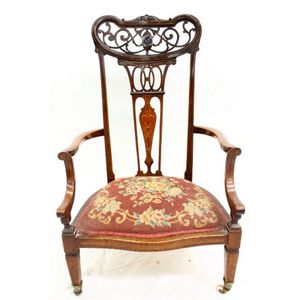Mahogany Tapestry French Chair, 19th Century
You must be a subscriber, and be logged in to view price and dealer details.
Subscribe Now to view actual auction price for this item
When you subscribe, you have the option of setting the currency in which to display prices to $Au, $US, $NZ or Stg.
- Mahogany - Mahogany is a dense, close grained red-coloured timber from the West Indies and Central America. It was first imported into Europe in the the early 18th century and its use continued through the 19th century. It was popular for furniture making because of its strength, the wide boards available, the distinctive grain on some boards, termed flame mahogany and the rich warm colour of the timber when it was polished.. The "flame" was produced where a limb grew out from the trunk of the tree, and this timber was usually sliced into veneers for feature panels on doors, backs and cornices.
Some terms used to describe mahogany relate to the country from which it originally came, such as "Cuban" mahogany, "Honduras" mahogany etc. However unless the wood has been tested the names assigned are more a selling feature, rather than a true indication of the timber's origin. - Cabriole Leg - The cabriole leg evolved from an elongated scroll, curving out at the knee which may or may not be carved, and forming a serpentine shape as it descends to the foot.
First introduced into English furniture in the late 17th century, cabriole legs were widely used during the Queen Anne and early Georgian periods, where they frequently terminated in a pad foot or ball and claw foot. The style has had many imitators since then. The cabriole leg was re-introduced in the mid-19th century, and is commonly associated with the balloon-back dining or drawing-room chairs made in walnut, mahogany or, in Australia, cedar. The Victorian cabriole leg, on the whole, was rather more slender than the earlier form, following the French style, which emphasized the delicacy and daintiness of the chairs they were designed to support. Cabriole legs are sometimes found on windsor chairs, especially those made during the 18th century. - Foliate - Decorated with leaves or leaf-like forms.
This item has been included into following indexes:
-
chairs, singles / pairs / threes, style or period
- French 949
- Victorian, other styles 1,179
- chairs, singles / pairs / threes, timber - mahogany 1,098
Visually similar items

An antique Louis XV-style rosewood and walnut fauteuil, latter half 19th century, with a crested cartouche-shaped padded back and out-swept open arms above the seat, on cabriole legs, carved and moulded throughout. Height 98 cm. Width 59 cm. Depth 67 cm

A Edwardian mahogany nursing chair, c.1910, with inlay and upholstered with tapestry, some minor fretwork damage, aged upholstered tapestry complete, white porcelain castors in tact, height 96 cm

A pair of decorative Chinese rosewood ornately carved elbow chairs

A set of four Victorian balloon back chairs, mid 19th century, the chairs with a squared back and a shaped mid rail with a circular Celtic style motif to the centre, drop in seats and tapering turned and reeded front legs, splayed to the rear; upholstered
